|
|
FARM 13 / STICK MARSH FISHING REPORTS
DECEMBER 2005
31 December 2005
This is a heck of a way to close out the 2005 fishing year. It has been one of the best on record and we have caught a LOT of bass and a LOT of giants. But---------
We’ve got a problem, sports fans. The Farm 13/Stick Marsh impoundment fishery may be at its lowest productivity level ever. And, it just happened recently.
In the 17 years I have been fishing it, the impoundment has ALWAYS been the number one place for quantities and trophy bass, plus lots of big crappie. But, that has changed dramatically. Just ask any of the hundreds of anglers who visited the impoundment over the Christmas and New Year’s period. As of 20 December, the water flow from the Southeast corner spillway in Farm 13 started to diminish and we basically lost our only predictable bass location. There was one day when another guide and I happened on the Farm 13 pump house running and we did very well. But, that was an anomaly that cannot be counted on.
The problem appears to be the terribly dirty water caused by the rotting vegetation ripped up by the 2004 hurricanes. Nearly all the open water vegetation (milfoil, hydrilla) was torn from its roots. We had hoped it would re-root during the summer of 2005. But, it appears to have rotted instead. The water is full of suspended materials and become even more sediment-laden when the winds kick up. As a result, the fishing is poor.
The sub-surface aquatic vegetation of the Farm 13/Stick Marsh impoundment may not re-establish itself for a number of years. Sunlight, vital for aquatic vegetation growth, simply does not have the ability to penetrate the silted waters to a reasonable depth. Without vegetation, there is no photosynthesis to generate oxygen. If the low-level oxygen condition we suspect does, in fact, exist, there may be the expectation of a fish kill in the Farm 13/Stick Marsh impoundment in the future.
This appears to be a really major, widespread issue. I have been advised that similar conditions exist on Lake Okeechobee, West Lake Toho, Lake Kissimmee, Lake Walk-In-Water, and Kenansville Lake. The water quality issue may not be as severe on those bodies (I visited Kenansville Lake and it is very poor), but it apparently does exist.
I have written a short information paper on the condition and forwarded it to people who can assess the situation and possibly determine some solutions. I will advise you of what I find out.
In the meanwhile, I will be contacting all of you who have future trips booked with me, to advise you of the conditions at that point and my expectations for a successful fishing experience. If it appears we will not be successful, I will suggest you re-schedule, or cancel. You can always get me at 321-951-7841.
The fantastic Farm 13/Stick Marsh has been a once-in-a-lifetime angling experience for many. I certainly hope it rebounds.
December 31, 2005
Betty Jean and Carl Rhodes have fished with us a few times before. I advised them of the poor fishing, but they elected to go.
We started out in the SE spillway basin in Farm 13 and did manage 11 fish pretty quick. They were small, but went after the shiners on the surface. That was a good sign! The water flow was almost nil, but the winds were low. So, the basin water was clean. But, 11 bass was all we got, so we went hunting.
We went up to the pump house on the east wall of the farm and found it running very slightly. Almost as soon as we arrived, the maintenance man stopped the pump and the water flow. We still set up and fed the shiners out, knowing the bass usually stay for an hour, or so, after the water stops. Sure enough, there were some hanging out on the top of the submerged levee and we managed another dozen before it was all over. Betty Jean was the heroine on the Pump house this day, with a 9 lber. and a 6 lber. Carl caught the most, with average being around 3+ lbs.
This was an anomaly situation. It will not produce if that water does not run. But, it does say the fish should be able to be caught elsewhere, even with the terribly dirty water.
Maybe I am missing something here. However, all the other anglers seem to be in the same boat. So, it is just not me. But, I have all of 2006 to try and figure it out!!
December 30, 2005
We cancelled a trip scheduled for 28 December and I went alone to hunt fish. All I was able to do was small bass late in the day.
Our party for the 29th, John and Ken, had already been advised that things were not good with our fishing. I had recommended they cancel and save thei4r money for a better time. But, Ken was moving to Arizona and wanted to make this one last trip.
So, we tried and tried hard. But, it was not to be. A few fish late in the day was all we could do.
December 27, 2005
I had gone to the Marsh alone just before Christmas and had actually caught some fish on crank plugs in the wood at the south end of the Farm. So, I was hoping that the fishing would come back.
Rod Martin and Robert Hitson had booked a trip sometime earlier. I advised them of the situation with the water. We decided to try it.
The situation did not improve. The bass were uncooperative on the plugs, as well as shiners. We dragged shiners for 2 miles around the south end of the Farm. Not one strike came. That is serious stuff when natural live bait fails to generate a response.
We did manage a few fish late in the day, but they were all small.
December 19, 2005
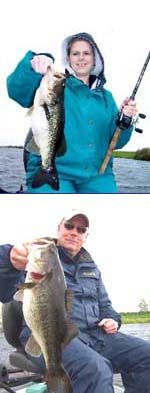 We hosted Mike Miles, his wife, and Jerry Petty on the Marsh. Mike and jerry had been out with us before, when we got to show them great shiner action and big schools of bass on shellbeds. This time, it was very different. Although we did get a few good pictures, this was the day that our bass success started to decline significantly. We hosted Mike Miles, his wife, and Jerry Petty on the Marsh. Mike and jerry had been out with us before, when we got to show them great shiner action and big schools of bass on shellbeds. This time, it was very different. Although we did get a few good pictures, this was the day that our bass success started to decline significantly.
What happened was that the water flow from the spillway in the SE corner of Farm 13 was gradually slowing. With no clean water coming in from the outside marsh and the NW winds blowing directly into it, the spillway basin began to backfill with the dirty water from the main Farm 13 basin. We caught fish early. But as the water flow neared just a trickle, the fishing all but stopped. I can’t say anymore to describe it any better.
December 16, 2005
Over the past two weeks, we have learned a few things and put together some data, which should be of benefit to those planned to fish the Stick Marsh soon.
The water is still somewhat dirty with suspended matter in the Farm 13 and in the Stick Marsh. All that grass that the hurricanes of 2004 destroyed are now rotted and covering the bottom of the impoundment. Any significant windy condition causes the water to churn and stirs up the vegetation that remains. Using the similar situation that exists in Lake Okeechobee as a prediction tool, I am pretty sure this condition is going to persist. The only thing that will let the waters clear sufficiently would be the total lack of wind for a week, or so. From now until April, that is just not to happen, our windy season continues until then. Okeechobee has maintained its poor water quality for quite some time now, with the only decent water being in the few areas of remaining vegetation that the 2004 hurricanes did not destroy. That vegetation filters the water and knocks the suspended particles out of it. Our impoundment, unfortunately, doesn’t have any remaining vegetation in the open water to do that filtering. And, it may be awhile before any grows back sufficiently to do the job.
The only clean water is that which comes through the southeast spillway in Farm 13. That water comes from thousands of acres of marsh and farmlands, passing through Garcia reservoir before entering Farm 13. Garcia, because it was well shielded from the mammoth winds of the hurricanes, actually has an over-abundance of hydrilla and Eurasian milfoil grass. These grasses are really cleaning the incoming flow. But, the clean water quickly becomes diluted when it gets to the main body of Farm 13.
But, don’t think we cannot catch bass. We have been fortunate to do exceptionally well since October. My logbook count shows that, since 6 October, we have caught and released 1391 bass. Another pretty amazing statistic is that over 20% have been 5-lbs, or better. There have only been nine that went over 10-lbs. Richard Rasey, after fishing with us the day before, took a 13-lb. giant fishing when out on his own.
The best way to assure a great trip has been to rely on live shiners. And, they have certainly done the job well. But, the bass CAN be taken on artificials. It seems that a bit of searching is required. But, once located, the do well on crank plugs. I have used a Rebel Deep Wee R and a 1/3 oz. Big O very successfully in the south end of Farm 13. I fished the thickest concentrations of stumps and downed trees that I knew of. The RIPPIN’ Stick jerk bait, in JuneBug, has done fair. But, it really has to be fished slowly and the strikes are very light. Spinnerbaits should be a key lure under the murky water conditions, but I have not found them to do well.
Where in the past, moving water locations have been gathering places for vast hoards of bass, these locations have not produced much at all. The pump on the east wall of Farm 13 in a good example. It ran water nearly all of October and November, but we never found bass gather there even one time. Those who have fished the SE spillway have encountered the same situation. A few can be caught on shiners, but the artificials have been, for the most part, ignored. Some of us, who are lucky and get to fish the impoundment a lot, have found ways to compensate and have done very well. But, even some of the regular anglers have had a lot of trouble hooking up.
Whether you elect to fish artificial lures or shiners, my advice would be to cover an area thoroughly and don’t hesitate to move if you don’t find fish. DO NOT stay in a location just because you have done well there before! Conditions are NOT the same any longer. Feel free to contact me for the latest conditions.
December 15, 2005
Father and son team, Gary and Chris Atwell, wreak a lot of havoc on the tournaments in Virginia. Chris is also a fast-burner on a couple of the ESPN/BASS tournament circuits and the Virginia Federation, and recently qualified for the classic of one of the tournament trails. That classic is to be held on East Lake Toho, at St. Cloud, Florida, in mid-January 06. The winner gets a berth in the BassMasters Classic in February!! Needless to say, Chris figured he had better get a look at this lesser-known of the major tournament waters. Gary, being an old fishing buddy from way back, called me to see what I might know about East Lake.
After Gary and Chris drove all night from Virginia to the shores of East Lake Toho, we met and mapped a plan to try and get Chris familiar with the lake. Being a natural Florida lake, East Lake is just a big, round sinkhole, surrounded by thick lines of reeds, some grasses and a lot of lily pad field. There is no open water vegetation and virtually no offshore structure. There are a few residential canals leading off of it into some housing areas, but they are few. Did I mention that there would be 50 boats in this event?? I suspect the fish-producing areas will become known to all rather quickly and they will get very crowded. I know there will be spawning activity in the canals during the tournament period. But, with all the contestants and just a few canals, that may be a self-defeating pattern. I told Gary and Chris that I suspect the winner will be someone who finds a group of fish congregated in a particular area of the shoreline reed, thus hiding him from the sight of the other contestants. This should be an area with possibly some type depth differences, or variations, and possibly some manmade topography changes.
Our day of exploring found lots of reeds and pads areas that held chain pickerel and an occasional bass. We also found some very isolated minor manmade ditches with adjacent dirt mounds. With Chris and I in one boat and Gary fishing alone, Gary stumbled onto an area of reeds and grass that was also a bit obscure and seemed to have a good concentration of fish.
This will be an interesting tournament. The winner had better make a big showing with a strong catch the first day. It is going to get tough if 49 other boats descend on his honey hole the next morning.
December 14, 2005
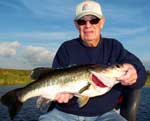 Ron Norris is a regular client and a good friend. And, whether Ron brings a friend along or his Dad, he always seems to bring cold, wet weather. I looked back at the pictures from three trips out and all I could see (besides the bass they caught) were dreary skies and heavy jackets. I guess Ron wants to feel at ‘home’ when he fishes in Florida. In fact, here is what we wrote in his last trip report -- “Seems like everytime we go out with Ron Norris, from the freezer box of Michigan, it rains and blows like the dickens.”
Ron Norris is a regular client and a good friend. And, whether Ron brings a friend along or his Dad, he always seems to bring cold, wet weather. I looked back at the pictures from three trips out and all I could see (besides the bass they caught) were dreary skies and heavy jackets. I guess Ron wants to feel at ‘home’ when he fishes in Florida. In fact, here is what we wrote in his last trip report -- “Seems like everytime we go out with Ron Norris, from the freezer box of Michigan, it rains and blows like the dickens.”
Well, I got a call from Ron last week. Seems like he is shoveling that snow a bit early this year. In fact, it must be pretty deep in Michigan now, as the avid angler said he wasn’t going to make it down for a fishing trip until next Spring! He really liked taking a quick Florida tan and some trophy bass pictures back to show the folks in the frozen north, so I know things must be tough.
But, then, there is his Dad, Al. Al is retired and lives just a short way from the Stick Marsh. Al also has a boat in his driveway. Al also likes to fish. Al already has a Florida tan. Al wanted to send some big bass pictures to sort of ‘rub Ron’ a bit.
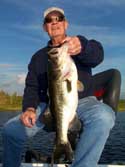 Al got his wish. Ron called me and he was, in fact, ‘rubbed’.
Al got his wish. Ron called me and he was, in fact, ‘rubbed’.
I was probably the most surprised guy around when Al and I met at the ramp. The sun was shining and the air was warm. I looked around, expecting to hear the band playing and the girls giggling, too. It sure was nice. To top all that, nearly all the boats on the water were crappie fishermen. We left the ramp with six dozen shiners and great expectations.
We started out free-lining shiners in a known good location. In fact, I had just waxed the fish good in that spot twice earlier in the week. I am sure glad the weather was nice because the bass were gone! Even the pickerel, shiner pickers that they are, were absent. It was certainly a strange scenario. The only thing that had made any change to conditions was a cold front passage a day earlier, but that was not all that strong. We took maybe a half dozen bass in the first hour, with one being around 6-lbs. One thing we noted quickly was that the bass appeared to be deep and would not blow a shiner up on the surface. So, we made sure the shiners stayed down, even to the point of tangling in some dead roots and trash occasionally.
Then, it just got so slow, I actually started re-positioning the boat. Each time I moved the big Blazer rig, we would get two or three more fish and then it would go dead again. I guess the key was to stay in near-constant motion and pick up as many of those two’s and three’s as we could. We noted that if we got close to a shoreline, the pickerel began to show up. So, we tried to stay out in the open water and keep the shiners down deep. It was slow fishing, but we steadily got bass. However, most were only 2.5-3 lbs.
I always preach that the second half of the day is ALWAYS better fishing in Florida. I think that is doubly true during the colder months, when the sun finally warms the waters back up by afternoon. I repeated this bit of philosophy to Al and reminded him that he was still in the boat with the World’s luckiest fisherman, as I moved the Blazer back to our original starting point.
This time, I rigged shiners for both deep and shallow presentations. The shallow riggings used no weight, but did include a small crappie bobber about three feet up the line to give the shiner some incentive to stay shallow. Holy mackerel, Andy, it all started from there!!! I suppose the water had warmed up, as predicted. Whatever it was, the bass were now in the area and would blast those shiners on top like a concrete block falling out of an airplane. Al was setting the hook constantly. Sometimes, he would make a hook set and I would take that rod and hand him the second one, advising that they was a bass after it, too. Crossed lines and two bass jumping at once – the fishing got really interesting!! In fact, it was so good that we invited a boat to join us. A gentleman and his lady, from near Ft Smith, Arkansas, had just set up a hundred yards away. We called and waved to them to ‘come on down’. I got them to anchor right next to us and showed them exactly what we were doing. They started to catch fish, too.
It wasn’t long before all the shiners were burned up and we had to start in. Al mentioned that he sure wished Ron could have been along, too. He also mentioned it sure was going to be sweet to put that ‘rub’ on his son.
December 09, 2005
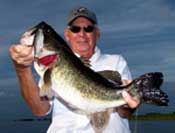 While I was finishing up a guide trip and putting the cover on the Blazer one afternoon, a car pulled up on the Stick Marsh ramp and Vernon Grizzard got out. He asked about the impoundment and said he wanted to fish it. After we talked awhile about the great fishing, Vernon booked a trip on the spot.
While I was finishing up a guide trip and putting the cover on the Blazer one afternoon, a car pulled up on the Stick Marsh ramp and Vernon Grizzard got out. He asked about the impoundment and said he wanted to fish it. After we talked awhile about the great fishing, Vernon booked a trip on the spot.
With Vernon age being 75, or so, he opted for a half day trip. So, we met at the ramp at noon with six dozen lively shiners bouncing around in the livewell.
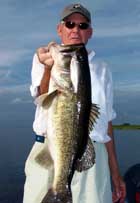 Settling in on two anchors, I baited up a pair of rods and sat back to watch the fun. It wasn’t long in coming, either! Shiners started getting blasted from the get-go. Doubles were a regular occurrence, with Mr. Grizzard trying to handle the demands of two big bass at once. Sometimes, I helped. But, most times, I just held the second rod and let the fish go with the shiner until Vernon had the first bass in. Then, we’d swap rods and he was off again.
Settling in on two anchors, I baited up a pair of rods and sat back to watch the fun. It wasn’t long in coming, either! Shiners started getting blasted from the get-go. Doubles were a regular occurrence, with Mr. Grizzard trying to handle the demands of two big bass at once. Sometimes, I helped. But, most times, I just held the second rod and let the fish go with the shiner until Vernon had the first bass in. Then, we’d swap rods and he was off again.
I really should have paid more attention to the workout Vernon was getting. But, I suppose I was too excited by all the action to notice. Approximately 20% of his 46 bass were 5 to 8 pounds. Just setting the hook was pretty strenuous. Vernon is a slight man, weighing maybe 140 lbs. Those big bass started just pulling him up out of his boat seat at times. He would set the hook on a bass and the bass would set back on him. Plus, all those big fishing pulling so hard for so long just about worn him down.
After about three hours of non-stop fish-catching, Vernon Grizzard threw in the towel, stating he was done for the day. Then, I realized what I had not done properly – I had not tried to pace him with the fish. I mentioned that we had three shiners left from that six dozen, but my new fishing friend said to let them go.
Those Stick Marsh bass can be hazardous to one’s health and wellbeing, methinks!!.
December 06, 2005
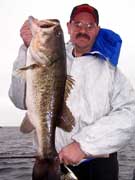 Ken Howe permanently resides in Florida now. But he used to spend the winters shoveling snow up in Wilkes-Barre, PA. Unfortunately, his long-time fishing pal, Bob Nahill is now doing the shoveling. Bob was visiting in Florida recently and Ken wanted to provide his buddy a ‘fishing trip to remember’. So, naturally, he called the ‘World’s Luckiest Fisherman’ (hey, sometimes it’s better to be lucky than have to be good!). Ken Howe permanently resides in Florida now. But he used to spend the winters shoveling snow up in Wilkes-Barre, PA. Unfortunately, his long-time fishing pal, Bob Nahill is now doing the shoveling. Bob was visiting in Florida recently and Ken wanted to provide his buddy a ‘fishing trip to remember’. So, naturally, he called the ‘World’s Luckiest Fisherman’ (hey, sometimes it’s better to be lucky than have to be good!).
The 6th day of December, 2005, absolutely was, without any question or any doubt, a fishing trip to remember!! It was one of those special days when so many giant bass came over the side of the big Blazer boat that even my head is still spinning. I am not sure about Ken, but I know Bob left with a bit of shellshock.
And, of course, we had our normal ‘unforgettable moments’ on this adventure to the fabled Stick Marsh. Read on; it’s well worth your time.
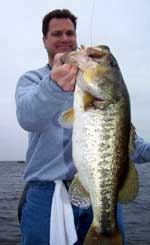 The weather was looking tough when we arrived at the Stick Marsh ramp. The winds were howling out of the NE, thanks to a cold front passage the night before (hummm -- fish are not supposed to bite right after a cold front, I’ve heard). The air was nippy, and made even more so by the strong, steady winds. It took two of us to get the boat cover off, as the winds tried to para-sail it away. Before heading out, we knew the big rollers on the water would probably toss a lot of spray into the air as we cut through them, so on went the FroggToggs. Then, we set a course for the semi-protected spillway basin in the southeast corner of Farm 13. The weather was looking tough when we arrived at the Stick Marsh ramp. The winds were howling out of the NE, thanks to a cold front passage the night before (hummm -- fish are not supposed to bite right after a cold front, I’ve heard). The air was nippy, and made even more so by the strong, steady winds. It took two of us to get the boat cover off, as the winds tried to para-sail it away. Before heading out, we knew the big rollers on the water would probably toss a lot of spray into the air as we cut through them, so on went the FroggToggs. Then, we set a course for the semi-protected spillway basin in the southeast corner of Farm 13.
Although we saw a few trailers in the parking lot, we were not to actually see another boat all day. I suppose the elements just looked to bad for most. But, the old adage that says ‘No guts; no air medal’ applied this day, for the fishing was at it’s best!!
We initially sited the Blazer along a grassy shoreline and tossed the shiners out into the current flow. That produced a few bass, but it was slow. The fish came in spurts of 2-4 and then the action would die for a period. We decided to re-position the boat. Before we could even get the lines into the boat, our first ‘unforgettable moment’ occurred.
Ospreys, terns and pelicans were all hovering around and over us, hoping to steal a shiner when we relaxed our attentiveness to them. Sure enough, as we started to pull anchors, a big, strong Osprey swooped in and grabbed a shallow shiner. That is the first time I have ever seen a fishing rod and reel water-skiing across the surface! That osprey ripped the heavy outfit across the surface a good 75 yards, throwing a heck of a wake and amount of spray in the process. I’ll bet that rod and reel was doing 40 MPH across the water. Thankfully, the rig was too heavy for the bird to lift clear of the surface. He eventually ripped off the shiner and the outfit dropped down by the spillway. Also, thankfully, there was enough line out that the bobber made it to the surface, over the deep-sixed rod and reel. We motored down, retrieved the outfit, and gave the osprey the single-finger salute. The big bird never looked up, as he perched comfortably on the tree limb munching the shiner.
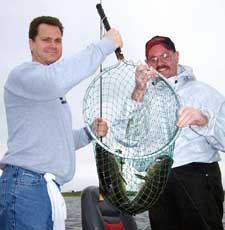 Now that we were up at the mouth of the spillway, we noted that there was a very light water flow coming out. So, we opted to re-position the Blazer in a special spot. We knew the small amount of current would be channeled through a narrow passage, in-between a shell bed-covered bar and a series of underwater shallow mounds. That narrow passage would make the moving volume of water speed up as it went through the narrow passage. As the spot was actually in the teeth of the wind, we set the boat up with two big anchors off the bow, placing them over one of the mounds to get a grip. Then, we played out 40 feet of rope to get the boat in the proper location. Now that we were up at the mouth of the spillway, we noted that there was a very light water flow coming out. So, we opted to re-position the Blazer in a special spot. We knew the small amount of current would be channeled through a narrow passage, in-between a shell bed-covered bar and a series of underwater shallow mounds. That narrow passage would make the moving volume of water speed up as it went through the narrow passage. As the spot was actually in the teeth of the wind, we set the boat up with two big anchors off the bow, placing them over one of the mounds to get a grip. Then, we played out 40 feet of rope to get the boat in the proper location.
We started with our shiners rigged weightless, but with small crappie bobbers as strike indicators 4-5 feet up the line. Initially, the bass harassed the shiners on the surface, blew up on them, and then took them. They were nice 3 and 4 lb. Fish, but the action was not as rapid as we had been experiencing. So, we decided to try straight free-lining without the bobbers. Holy smoke!! That was the key! I don’t know if it was the strong surface chop or the cooler water temperatures from the cold front that caused the fish to apparently stay deeper. (Someday, I am going to get to talk to a fish and I have a LOT of question to ask!) Whatever it was, ‘deeper’ appeared to be the case.
Almost immediately, the strikes began to come rapidly. And, the fish were much larger. In fact, many were in the 5-7 lb. range. Every so often, one of the anglers would get an even larger one. A few pickerel worked the shiners, but Ken and Bob quickly adapted and learned to effectively make the pickerels drop the shiner. That saved a lot of bait that would have otherwise gone to waste.
FISHY TIP OF THE DAY: The way we make the pickerel drop a shiner is simple, but it takes some experience to be able to recognize that the strike is a pickerel and not a bass. The bass usually take the shiner and that’s it. No if’s, and’s, or but’s. He’s got it and he’s heading off. A pickerel seems to like to toy with the shiner, grabbing the tail and pulling it around. Sometimes the strike indicator bobber never goes under. Other times, it goes just barely under, but still stays in sight. As for distinguishing the difference in a pickerel and a bass blowing up on the shiner, the level of violence is the key. The pickerel often swirls on the shiner and you can see his tail break the surface. Occasionally, it is a strong strike; but, not usually. The bass, on the other hand, strike hard and with power to stun the prey. It is totally different. Once you see enough of these strikes, you will be able to tell which fish it is 80% of the time. To get the pickerel to drop the shiners, you just tighten the line and make the pickerel tug back at you once. When he feels you, he will most often drop the shiner. If it happens to be a bass, his first tug will be followed by a ‘give me that, it’s mine’ run.
The action really got going for a period and we wound up with doubles coming at a rapid pace. More than a few times, we had to net two big, scrappy bass at one time. It’s tough having to fish the Stick Marsh!
Alas, even this action started to finally slow down a bit. We noted that only a few shiners remained, so we opted to try for a true giant fish with the remainder. Moving down near the spillway, we set the boat up on a location that has produced many double-digit bass for us. Our friend, Richard Rasey, got a 13 lb. giant there recently. The first 5-6 fish were just fish. Good to catch, but not big. Then, Bob got a nice one in the 6-lb. range. Next, we found two of the free-lines crossed. We reeled them in and I started unwinding them. Just as I dropped line number one back into the water, line number two (now wrapped snugly around my hand!) started to move away. I pulled back from instinct, but it still moved away. It felt like a slowly rolling Volkswagen was on the line. Ken grabbed the rod, I freed my hand and in came a twin to Bob’s fish. Ken moved to the back of the boat and started swimming his shiner out in an unfished area. He got 3-4 fish quickly.
Then, there she was! A big old girl! She was too big to jump, but did make a heck of a boil on the surface. Ken led her right to the net and aboard she came. We did not weigh her, but she was around 28 inches long. Since her belly was not bloated like most of the other bass we were catching, we figured she was closer to 9.5 than 10 lbs. But, she was quite a sight as bass go. It was fine way to end a great fishing adventure!
December 05, 2005
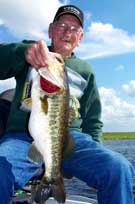 Bruce Smith lives down in the West Palm Beach area. That last danged hurricane, Wilma, didn’t do him, or the folks in that area, any good at all. What was billed to be a mild storm with most of its power and effects impacting the western landfall area of Florida, turned out to be a real barnburner for all of the southern part of the Sunshine State. It fact, the worst winds came AFTER the eye passed and were really tough on the East Coast. Bruce’s father-in-law, Del, came down from Iowa to help Bruce and his family clean up and get their lives back in order. In fact, Bruce gives Del credit for doing nearly all the effort, while he had to go back to work. A fishing trip on the famous Stick Marsh was his ‘Thank You’ present to Del. Boy, did those bass say ‘Thank You’ in a big way, too!! Bruce Smith lives down in the West Palm Beach area. That last danged hurricane, Wilma, didn’t do him, or the folks in that area, any good at all. What was billed to be a mild storm with most of its power and effects impacting the western landfall area of Florida, turned out to be a real barnburner for all of the southern part of the Sunshine State. It fact, the worst winds came AFTER the eye passed and were really tough on the East Coast. Bruce’s father-in-law, Del, came down from Iowa to help Bruce and his family clean up and get their lives back in order. In fact, Bruce gives Del credit for doing nearly all the effort, while he had to go back to work. A fishing trip on the famous Stick Marsh was his ‘Thank You’ present to Del. Boy, did those bass say ‘Thank You’ in a big way, too!!
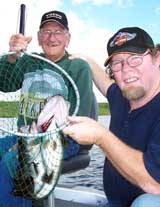 With a pretty fair wind blowing from the southeast, we pointed the Blazer boat across the Stick Marsh and down to the south end of Farm 13. Lucky for us, the south end made for a good windbreak and we were pretty comfortable. Using anchors at each end of the boat, we set the rig perpendicular to the wind, so we could keep the shiners downwind off the boat with ease. With a pretty fair wind blowing from the southeast, we pointed the Blazer boat across the Stick Marsh and down to the south end of Farm 13. Lucky for us, the south end made for a good windbreak and we were pretty comfortable. Using anchors at each end of the boat, we set the rig perpendicular to the wind, so we could keep the shiners downwind off the boat with ease.
The bass were there. I think the word must have been out that we were coming, because there was quite a big old bunch of them to greet us. There were little bass and middle-sized bass, and big bass, and a few of those critters we call ‘giants, too!! And, they were all hungry!
Del let the fish know that he knew what it was all about by nailing a nice solid 4 lb. bass right off the bat. Then, Bruce jumped in a got them going. I could see the shiners weren’t going to last long this day and secretly wished I had advised the guys to get more. The catching pace was great, with the bass blowing the shiners up in a hair-raising demonstration of surface obliteration. Some of the shiners actually got knocked nearly three feet into the air by the ravenous fish. That kind of action is what makes this type fishing so great!
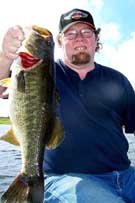 Doubles started becoming common, as each angler would hook up at nearly the same time. And, each time this happened, the fish would be both nearly the same size. I can only attribute that to a school moving by us. Doubles started becoming common, as each angler would hook up at nearly the same time. And, each time this happened, the fish would be both nearly the same size. I can only attribute that to a school moving by us.
As the bass came to the shiners in rapid succession, in started to look as though Bruce and Del were locked in a ‘who is going to catch the biggest bass’ contest. One would get a 4 lb. bass and, then, the other would get one larger. Pretty soon, Bruce landed two giants of around 25 inches. Not to be outdone, Del got one that big and then he scored the giant of the day – a bruiser of almost 27 inches. In another month, with pre-spawn weight on, that old gal will be a true trophy fish!! It was quite a sight to see Del set the hook on that big old gal. He set the hook on her and she set the rod and reel on him. She was so heavy and powerful that Del never did even get the rod much above eye level on the set before she pull him right up out of his boat seat and the rod tip into the water!
Like I said earlier, I think Del got his big ‘Thank You’, in spades!
December 1 and 2, 2005
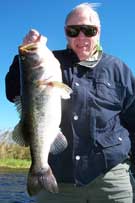 Walt Lafary is an old friend. He has fished with us before, having let us introduce he and his brother-in-law, Bob Richter, to the ‘Earthly Delights’ of the Stick Marsh last year. That was one magnificent trip. Walt and Bob wanted another shot at our giant bass. And, this time Walt’s son, Mike, decided to come along. He said the pictures from last year’s trip were ‘too much’. Boy, I wonder what he is going to call the ones from THIS trip?! Awesome, spectacular, unreal – all fit pretty well. Walt Lafary is an old friend. He has fished with us before, having let us introduce he and his brother-in-law, Bob Richter, to the ‘Earthly Delights’ of the Stick Marsh last year. That was one magnificent trip. Walt and Bob wanted another shot at our giant bass. And, this time Walt’s son, Mike, decided to come along. He said the pictures from last year’s trip were ‘too much’. Boy, I wonder what he is going to call the ones from THIS trip?! Awesome, spectacular, unreal – all fit pretty well.
Day one found the sun bright and the winds whistling in from the northwest like the Ides of March. If one was prone to becoming seasick, this could have been the day. Looking at the wind direction and what little windbreak we were to have in our chosen fishing spot, I laid the Blazer out perpendicular to the wind, using three anchors. I actually let the first one drag a bit until it caught and then laid out the two smaller anchors together. That stopped us, except for the incessant rocking and rolling in the waves (thankfully, the winds gradually diminished during the day).
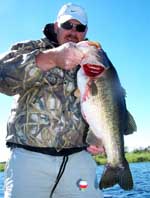 The bass were right where they were supposed to be and the action started off with a bang (well, maybe a bunch of bangs!). Mike and Bob hammered the bass at a steady pace, with a lot of nice 4-6 lb. fish coming to the net. Walt, however, seemed to have forgotten his lucky rabbit's foot and the bites were pretty sparse at his end of the boat. That is sure one of the strange things about fishing that remain totally unexplainable to this day. How can one person catch fish at a rapid pace and, 15 feet away using the same baits and equipment, another person struggles to even get a bite? (Someday, I am gonna get to talk to that fish!!!! That’s question number 47. Don’t forget!) Walt is certainly no slouch at fishing. Heck, the man has fished all over the World with great success. So, it certainly wasn’t his fault. (But, Walt’s revenge will come. Just wait!) The bass were right where they were supposed to be and the action started off with a bang (well, maybe a bunch of bangs!). Mike and Bob hammered the bass at a steady pace, with a lot of nice 4-6 lb. fish coming to the net. Walt, however, seemed to have forgotten his lucky rabbit's foot and the bites were pretty sparse at his end of the boat. That is sure one of the strange things about fishing that remain totally unexplainable to this day. How can one person catch fish at a rapid pace and, 15 feet away using the same baits and equipment, another person struggles to even get a bite? (Someday, I am gonna get to talk to that fish!!!! That’s question number 47. Don’t forget!) Walt is certainly no slouch at fishing. Heck, the man has fished all over the World with great success. So, it certainly wasn’t his fault. (But, Walt’s revenge will come. Just wait!)
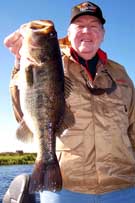 Pretty soon, the odds start to take over. Mike and Bob caught so many fish that the odds finally started to bring some really big bass to them. The viewfinder of my camera was covered up with them. Bob got 2-3 big ones in a row and, then, bingo – old Mamma Bass grabbed his shiner. That was quite a tussle, too, as she tried to get into the motor and under the boat. But, eventually Bob and the steady pressure of no-stretch Fireline wore her down and into the net she came. Next, it was Mike’s turn. Looking through the pictures, I find about six pictures of Mike with six different big bass and it is hard to tell which is really the largest. Mike is a pretty big guy and it tends to make the fish appear a bit smaller. So, I started to look at belly size and girth and found what appears to be his largest, around 27 inches long as I recall. Pretty soon, the odds start to take over. Mike and Bob caught so many fish that the odds finally started to bring some really big bass to them. The viewfinder of my camera was covered up with them. Bob got 2-3 big ones in a row and, then, bingo – old Mamma Bass grabbed his shiner. That was quite a tussle, too, as she tried to get into the motor and under the boat. But, eventually Bob and the steady pressure of no-stretch Fireline wore her down and into the net she came. Next, it was Mike’s turn. Looking through the pictures, I find about six pictures of Mike with six different big bass and it is hard to tell which is really the largest. Mike is a pretty big guy and it tends to make the fish appear a bit smaller. So, I started to look at belly size and girth and found what appears to be his largest, around 27 inches long as I recall.
The next morning found us all ready to get going. Even I had trouble sleeping the night before. Visions of bass blowing up shiners on the surface and bass flying through the air danced in my pointy little head! Heck, I do this most every day. You’d think I would be used to it. (Don’t kid yourself; I’m hooked on fishing!)
We got to the ‘magic spot’ quickly and laid out the anchors. Shiner started swimming and we got ready for action! And, we waited. And, we waited, and, we waited. Boy, did it start out slow. The guys got 8-10 real quick and then it just died. I mean, it was like you turned off the faucet. There was no weather change, no water change – nothing had changed since the marvelous day before. What was going on, we all wondered? (I started thinking about talking to that fish again. Question number 14, I think.)
So, we decided to move the boat around a bit; maybe change the location or the placement of the shiners. That worked some, but it got us a lot of fine pickerel holes, too. The bass were random. But, they were at least steady at that slow pace. After trying to get something going at four other locations, we opted to play the odds and go back to our original place. This time, however, I set the boat parallel to the location the fish should be, so that all could place their shiners right on the side of the drop-off.
Good gracious, did we get shocked. The bass had either moved in, or we had just found the presentation they wanted. Whatever the case, we didn’t argue! I was constantly netting bass, removing baiting hooks, re-tying hooks – sometimes two at a time. Although we all had fallen into the stinky stuff, Walt had come up smelling like the proverbial rose. Unlike yesterday, this was HIS time and he made the most of catching up. In fact, that picture of the guy in the tan jacket with the big smile is ‘old’lucky’, hisself! Look at that grin and at that bass. It doesn’t get better than that.
How about it, Mike. How do we describe it?!
November 30, 2005
We closed our Thanksgiving break out by going to the Stick Marsh and trying to solve the problem of artificial lures and the present murky water conditions. I really can’t say if we solved it, or not. We did catch 22 bass in 3 hours, with one going 6 (+) lbs. Whether is can be done again, I don’t know. Here is what we did.
We started in the Nursery area (coordinates B-3 on our interactive map on the web site). Of all things, we worked that stump and wood infested area with a Rebel Deep Wee R crank plug. The water is only 7 feet in the Nursery, getting progressively shallower as you work to the south. The Deep Wee R runs around 9-10 feet on most applications, so we were really beating up and bouncing of the submerged wood. Strangely, I never got hung up a time. But, I did get 7 bass in the 2 to 3 lb. range there. The strikes would come as the bait bounced off something (heck, it was ALWAYS bouncing off something). From there, I eased over to the submerged canal trace and timber at coordinates C-2 to C-3. I used the same Deep Wee R until I got into 5.5 feet of water. Then, I started to hang up too much. So, I went to the ‘little green plug’, the 1/3rd oz. Big O in Firetiger color. It turned 6 bass in just a few moments, so I moved on. The south-central section of the Farm produced no fish. Finally I found another good bunch along the submerged canal at coordinates F-2,3. These were solid 3.5-4 lb. bass, the same size as those we caught schooling in there last year. As earlier stated, that was one afternoon. I don’t know if it will work again.
My records from years past show that the small buck bass will start a mass exodus to the shallows in mid-December. The larger pre-spawn bass will start to stage in late December. The best areas for the big females have always been the north levee of the Stick Marsh and the southwest wall of Farm 13. Sometimes, the NW area of the Stick marsh is good. Since the water is murky, forget any sight fishing. Just take my word for it that they spawn in those locations (as well as others, of course). Look at past fishing reports for late December through the end of February (the primary spawning time in this area) and you will see lots of big bass. You will also see palm trees, a solid tip-off to the north end of the Stick Marsh. Shiners are about all that will tempt the pre-spawn and spawning fish well. If you find them on pre-spawn and active, the RIPPIN’ Stick, fished very slowly with a lot of drops, it the better artificial. READ THE PAST YEARS’ FISHING REPORTS!

Today's Weather for
the Stick Marsh Area
Past Stick Marsh Fishing Reports
Farm 13 / Stick Marsh Information Guide
Email questions to jporter@jimporter.org.
|
Recommended sites by The Fishin' Tipster |
A common question that we get: "Is there somewhere close to get bait and tackle?" This is where we get our bait.

Pete and Tina Heinz / 9 South Mulberry St. / Fellsmere, FL 32948 / 772-571-9855
Get your site listed here
Let us help you drive more targeted traffic to your site.
|


Rank our Site
ęCopyright 2001-07 All rights reserved by Jim Porter, any reproduction, quotation or other use of this site or its elements is prohibited without the express written permission of Jim Porter
|
|


 FROGG TOGGS RAIN GEAR
FROGG TOGGS RAIN GEAR
THE BEST PRICES AVAILABLE!!


|
|







